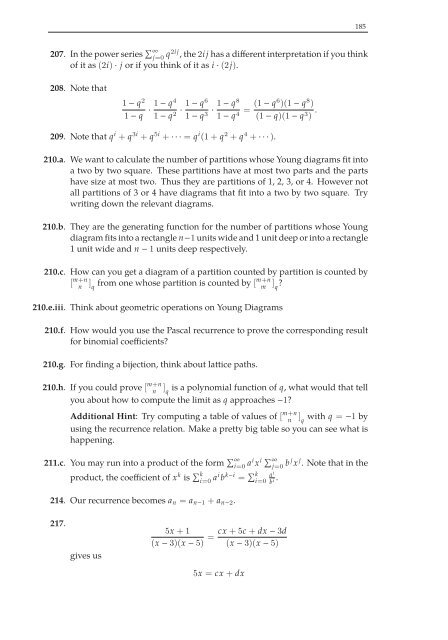Combinatorics Through Guided Discovery, 2004a
Combinatorics Through Guided Discovery, 2004a
Combinatorics Through Guided Discovery, 2004a
Create successful ePaper yourself
Turn your PDF publications into a flip-book with our unique Google optimized e-Paper software.
185<br />
207. In the power series ∑ ∞<br />
j=0 q2ij ,the2ij has a different interpretation if you think<br />
of it as (2i) · j or if you think of it as i · (2j).<br />
208. Note that<br />
1 − q 2<br />
1 − q · 1 − q4<br />
1 − q 2 · 1 − q6<br />
1 − q 3 · 1 − q8<br />
1 − q 4 = (1 − q6 )(1 − q 8 )<br />
(1 − q)(1 − q 3 ) .<br />
209. Note that q i + q 3i + q 5i + ···= q i (1 + q 2 + q 4 + ···).<br />
210.a. We want to calculate the number of partitions whose Young diagrams fit into<br />
a two by two square. These partitions have at most two parts and the parts<br />
have size at most two. Thus they are partitions of 1, 2, 3, or 4. However not<br />
all partitions of 3 or 4 have diagrams that fit into a two by two square. Try<br />
writing down the relevant diagrams.<br />
210.b. They are the generating function for the number of partitions whose Young<br />
diagram fits into a rectangle n−1 units wide and 1 unit deep or into a rectangle<br />
1 unit wide and n − 1 units deep respectively.<br />
210.c. How can you get a diagram of a partition counted by partition is counted by<br />
from one whose partition is counted by [m+n<br />
m ] q ?<br />
[ m+n<br />
n<br />
] q<br />
210.e.iii. Think about geometric operations on Young Diagrams<br />
210.f. How would you use the Pascal recurrence to prove the corresponding result<br />
for binomial coefficients?<br />
210.g. For finding a bijection, think about lattice paths.<br />
210.h. If you could prove [ m+n<br />
n<br />
] is a polynomial function of q, what would that tell<br />
q<br />
you about how to compute the limit as q approaches −1?<br />
Additional Hint: Try computing a table of values of [ m+n<br />
n<br />
] with q = −1 by<br />
q<br />
using the recurrence relation. Make a pretty big table so you can see what is<br />
happening.<br />
211.c. You may run into a product of the form ∑ ∞<br />
i=0 ai x i ∑ ∞<br />
j=0 b j x j . Note that in the<br />
product, the coefficient of x k is ∑ k<br />
i=0 ai b k−i = ∑ k<br />
i=0 ai .<br />
b i<br />
214. Our recurrence becomes a n = a n−1 + a n−2 .<br />
217.<br />
gives us<br />
5x +1 cx +5c + dx − 3d<br />
=<br />
(x − 3)(x − 5) (x − 3)(x − 5)<br />
5x = cx + dx


















